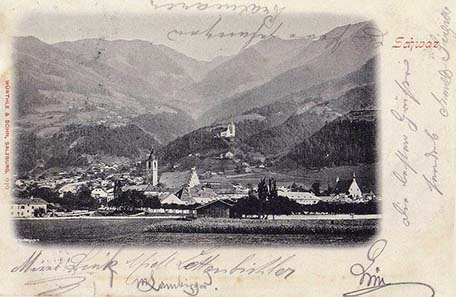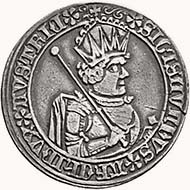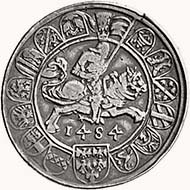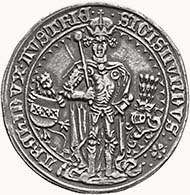The date was February 7th, 1496. Columbus hadn’t returned from his second journey yet, in the realm of the Holy Roman Empire everyone was upset about general taxation which had been decided at the diet at Worms one year ago, and the Syphilis which had been introduced from America spread all over Europe. Much happened those days indeed; and in a secluded chamber in the Innsbruck Residence a lonely man laid dying.
Archduke Sigismund of Tyrol, copperplate print 1623.
Sigismund on his deathbed
Archduke Sigismund of Tyrol, master of the then most profit-yielding silver mines of the world laid on his deathbed. He had huge reforms carried out in the European coinage. On his order the pfundner was struck, the sechser, the half guldiner and the guldiner which was to become model of all talers. Finally, on his deathbed, the archduke expressed one last wish: he wanted to dig his hands into coins, to feel the cool metal on his skin one last time. Sigismund asked his financial administrators to bring two pots with coins. But the gentlemen resorted to excuses: the cost of the budget, the funeral to come, the many debts and obligations one had assumed and was forced to pay back now. The dying archduke suggested that one could lend the money instead. He owned a small mine which yielded 100 gulden every week. As a matter of fact, a lender was found who advanced 400 gulden on loan to make sure that the archduke could cool his burning hands on the metal. Sigismund stayed alive for three weeks. Of the 400 gulden he paid 300 back. The remaining 100 gulden he owed his lender.
How was it possible that the master of the incredible profits of the Schwaz silver mines died an impoverished man with no more money left than the revenues of a small mine of his? Why hadn’t he managed his land’s profits more carefully? What political, economic and mental circumstances were responsible for the fact that during the Middle Ages and the Early Modern Period even the richest countries were plunged into ruin by the extravagances of their leaders?
Political circumstances
When Duke Frederick IV, father of Sigismund archduke to become, died in 1439 his son was only 12 years old. For the boy’s relatives this was a big chance. Legally, they were Duke Frederick’s liege lords and, in the case of his death, were rightfully entitled to a reallocation of the Duchy of Tyrol. If Sigismund had attained full age by then and had kept the country’s affairs firmly under control his Styrian cousin Frederick which was later to become German King would have had no chance to interfere in the order of succession. Since Sigismund with his 12 years of age was still a minor, it was a piece of cake for Frederick IV. In accordance with medieval feudal law he took the young man with him to his court to educate him. That the entire Tyrolian treasure took the same way displeased the estates but there was nothing anyone could do about it. Frederick IV was in the right! As sovereign of Tyrol he was entitled to seize the country’s revenues to administer them on behalf of his charge.
No wonder then, that Frederick really felt no need to release his nephew into majority and thereby into power. Sigismund had to pay a lot of money to make his uncle announce him full-aged and able to inherit. On March 31st, 1446, seven years after the death of his father, Sigismund made a contract with Frederick. In this contract Sigismund promised to pay the king an annual amount of 2.000 mark, that is 16.000 Rhenish goldgulden – an enormous sum. Apart from that, he had to pay a one-time compensation of 30.000 dukats, that is 37.500 gulden. As if that weren’t enough, the brother of King Frederick IV had to be paid off, too. To this end, Sigismund had to pay him an annual sum of 20.000 goldgulden for the duration of six years.
This was a heavy mortgage for the young ruler at the beginning of his reign. 37.500 dukats to pay at once, 36.000 goldgulden for six years to come and after that only 20.000 per year as long as it pleased King Frederick IV. Plus the treasury was empty. None other than his legal guardian had taken the money reserves and confiscated the land’s annual revenues. The young duke had no other option than to contract debts and lend money from ambitious merchants who were quite willing to accommodate. After all, Duke Sigismund owned an inexhaustible money source: in his country, near Schwaz, the richest silver deposit of those days was located.
View of Schwaz. postcard, c. 1900.
Economic circumstances
Sigismund held the mine regal to the effect that all natural resources came into his possession. At Schwaz, miners were digging as early as the first two decades of the 15th century. We do not know how much silver they mined. Only from 1470 onwards, exact numbers are documented when amounts are rising to incredible heights: in 1470 the mine ‘Alte Zeche’ alone mined 12.232 mark silver. We must estimate the mark at 281 gram. That means that during that year 3.437 kilograms of silver were mined which could have been struck into 10.764 guldiner. In 1480 already 7.724 kilograms of silver saw daylight, in 1490 it was 11.679 and in 1500 11.701 kilograms. Altogether, between 1470 and 1529 this pit alone mined 200.000 kilograms of silver and 15.000 tons of copper. And ‘Alte Zeche’ was only one of several mines. Apart from it, there were the Eisenstein, the Falkenstein, the Ringenwechsel to mention only a few.
According to the mine regal all silver would have belonged to the ruler if he had been capable to mine the silver at his own expense. For Sigismund, that was impossible to do. First of all, mining required investment and organization for which the duke had to rely on experienced entrepreneurs. In 1441, his legal guardian King Frederick IV himself had already vested the Herrengrube rights to Jakob Tänzl, an entrepreneur from Innsbruck. Thereby, a form of organization was found that was soon to become model in the entire realm: the system of trades. A rich entrepreneur acquired from his sovereign the right to exploit a mine. He alone was entitled to buy the mined silver from the miners working below ground which were organized in a sort of cooperative. In those days, the value of the unmanufactured and not yet struck silver was 10 to 12 gulden at the free market. Still, the sovereign had the right of preemption and did a deal with the trades for the silver at the set price of 5 gulden. The duke resold the silver for 8 gulden which was still far below the usual price. The difference of 3 gulden was called draft. These so-called drafts constitute the basis and the chief income for the finances of the archduke. Other taxes, tithes and socages were added to it.
In this regard, the duke received every tenth bucket of the mined silver-containing rock, hence the name tenth or tithe. This duty was called ‘fron’, socage – to us, that term is known from the institution of serfdom. The person responsible for the actual delivery to the duke was called ‘froner’, sokeman. The raw material was transported to the melter of the archduke with the result that the sovereign had free silver for his coins at his disposal.
Anton Fugger, “Prince of merchants”, temporarily relocated company headquarters to Schwaz. Painting by Hans Maler.
A roaring trade
This was a good deal for all parties involved. Sigismund obtained huge sums of money without much effort and the trades were able to generate incredible profits of their mine shares. Not only the difference between the mining costs and the 5 gulden Sigismund was paying per mark were left to them. In addition, they were entitled to sell the copper, which was mined in Schwaz as a byproduct of the silver, without any condition on the free market. Hence, everybody could have profited if Sigismund hadn’t constantly been in debts.
Sigismund refunded his debts with his share of the profits of the Schwaz mine. The procedure involved is illustrated by a loan that Sigismund obtained from the company of Ludwig Meutting at Augsburg on January 1st, 1456. The merchant provided 40.000 gulden. By that, he was entitled to buy the entire silver production of Schwaz for 8 gulden for a set period of time. He was obliged to give the trades 5 gulden and the sovereign 3 gulden. He made a personal profit of 2 to 4 gulden per mark silver. – And since in those days the merchants possessed excellent mines of information we may reasonably assume that Ludwig Meutting made good money with this loan.
A model was created by that and all trades tried to get rid of the obligation to sell to the sovereign – they rather wanted to have shares and get the bigger piece of the pie for themselves. Of course, Sigismund who was always in debts up to his ears was all too willing to sell his rights at the mined silver in advance.
In 1488 Sigismund needed 150.000 gulden. This was two times the sum that a single mine, the Alte Grube, had brought the duke in 1480 only for the draft. And the silver production rose annually between 1480 and 1490!!! But Sigismund was in urgent need of the money and the Fugger had cash in abundance. So the duke pawned all silver mined in Schwaz destined to be delivered to the Halle mint with a value of 200.000 gulden to Ulrich Fugger for one and a half years. During 18 months, the Fugger company made about 50.000 gulden on that loan alone which equaled an annual rate of 22%. A dream for any bank nowadays!
But Sigismund was not the only one who cut a caper. Under Maximilian this policy continued. Between 1491 and 1494, his bonds amounted to 286.000 gulden. In 1515 the chamber of the sovereign owed the Fuggers already 300.000 gulden. Maximilian’s way out of that was to pawn the Schwaz silver production to the Fuggers for eight years and the copper production for four years, respectively. An unwelcomed effect was that with this pawn the revenues of this most important source of income vanished as well. By that, Maximilian was forced to take on money and pawn the revenues of Schwaz yet again… With this loan the Tyrolean sovereign lost control over the production of silver and copper in Schwaz once and for all.
Archduke Sigismund of Tyrol. Half guldiner 1484, Hall, moneyer: Bernhard Beheim the Older, die cutter Wenzel Kröndl. From sale LHS 95 (2005), 266.
Archduke Sigismund of Tyrol. Guldiner 1486, Hall, moneyer: Bernhard Beheim the Older, die cutter Wenzel Kröndl. From sale LHS 95 (2005), 267.
The knightly duke as benefactor of goods
But why, anyone will ask, why did Sigismund and later Maximilian maladminister in that way? They were able to caluculate their revenues. Why did they constantly spend more money than they had at their disposal?
To answer that question we have to take a closer look at Sigismund’s coins. They tell us much about how the duke saw himself and testify that he couldn’t behave any differently than to spend money much faster than he gained it. His coins all have one element in common which we today take for granted and do not reflect on it anymore. They show him wearing the knightly suit of armour ready to go to war. He has put his left hand on the hilt – symbolic weapon of the knightly fighter – that had been presented to him in the festive accolade ceremony. On the reverse he rides to enter the fight with the tenure flag around which he collected his ‘banner’.
This was more than an old-fashioned way of self-expression. Sigismund still regarded himself as a knight. He devotedly cherished the habits and customs of an estate which in military matters had long become obsolete. He actively participated in tournaments and had the old heroic poetry collected at his court. These old epics were revived by bards surely more than once. Courage, bravery and loyalty – Sigismund will have imbibed these ideals with the chivalric novels of which he couldn’t get enough.
The virtue of generosity
Courage, bravery and loyalty – it is exactly these catchphrases that we associate with knights up to the present day. At the same time, our education plays a trick on us. Today we recognize only those elements that we still deem good and noble. We gladly neglect another virtue that we are not used to any more. But if we put away the notion of our century for once we will soon realize that the courtly poetry praised generosity as high as courage, bravery and loyalty.
A noble knight was expected to spend money as fast as he earned it, thieved it, won it in a game. Possession was obtained to be kept, to be given as inheritance to one’s heirs, garments and armour were decoration for oneself or the members of one’s retinue – but money’s sole purpose was to be wasted for the purpose to buy oneself a reputation of a very generous master. Only a generous giver was able to rally supporters. Only a benefactor whose money promoted buildings and art bought oneself eternal fame. After all, a knight wasn’t a merchant hoarding money for the purpose of making profits.
Sigismund was no exception. He built castles, funded artists and scientists. Wherever he came he handed out money. Sigismund had a reputation of letting himself get caught by the beautiful daughters in town only to pay a ransom of one gulden. One gulden was the weekly income of the miners of Schwaz in those days. And they were the then best-paid craftsmen!
Let’s have a look at Sigismund visiting his mint:
February 8th, 1486
And to the mint men was given, according to tradition, on Ash Wednesday 1 gulden and as my most gracious lord has been at the mint the same day he in his mercy was inclined to drink away 1 gulden, facit 2 gulden.
May 17th, 1486
But his Grace gave when his Grace had been at the mint on Wednesday during the Whitsun holidays in the year 1486, his Grace gave the assistants carrying him a zain as present for which he was given 24 pounds of pfennige; that zain his Grace has kept and one in addition, out of which his Grace had made a wreath around his hat, the two zain weigh one lot, in money 9 gulden…and to the mint men donated for the time to drink away 1 gulden, facit 15 gulden.
Any time the master visited the Hall mint it was a real festivity for the workers. The weekly salary was given out two and three times, sometimes even the monthly salary. The same procedure everywhere the duke came. He spent. His people regarded him as a donator of money in abundance. Was it any important that the money was a loan only? Who cared that the duke could have put his country’s economy back on its feet if only he had saved money?
When negotiating, Sigismund and the Fugger merchants were poles apart. There was the Archduke fond of his image as giver of gratuity who saw the money melting away as fast as he got his loans accommodated. And there was the Fugger as a citizen of a new era who had realized that all and everyone can be bought in a world where the dukes hadn’t yet understood that they by taking on loans they became dependent on the lenders.
The medieval dying ritual
But who are we to blame Sigismund for wasting his revenues? Shouldn’t we rather see ourselves with the eyes of a medieval man and ask ourselves what he may have thought about our saving and insuring mania? Sigismund could have died a rich man if only he had wanted to.
But that wasn’t the case since the knightly dying ritual involved getting rid of all worldly goods before death. In medieval times, a sudden death that left the regulation of heritage to a written will was thought a dire death. Not that death per se was regarded as dire. Rather, one was afraid of facing death unprepared with no chance to allocate one’s goods to fellow men in order to meet one’s maker as bare as one was born. Of course, the duke didn’t give away his possession to any stranger. No, he adhered to strict rules when allocating office, land, possession and money. During the weeks of preparation before dying, children and followers, convents and institutions received what the dying person wished to pass. This was the usual way for knights and rulers for centuries.
And what about the truth?
The legend of the dying archduke wishing to cool his hands on coins is a belated invention. What really happened may be gathered from a chronicle which reports for March 6th, 1496:
One has assembled (around his deathbed, author’s note) three basins with money, one with gold, the other with new sechser, the third one with new kreuzer. Likewise donation with sechser given to poor people.
Sigismund continued to be the prodigal to the last who didn’t spend his money on his country’s structural improvements but rather gave it to those standing face to face to him to make them happy.












